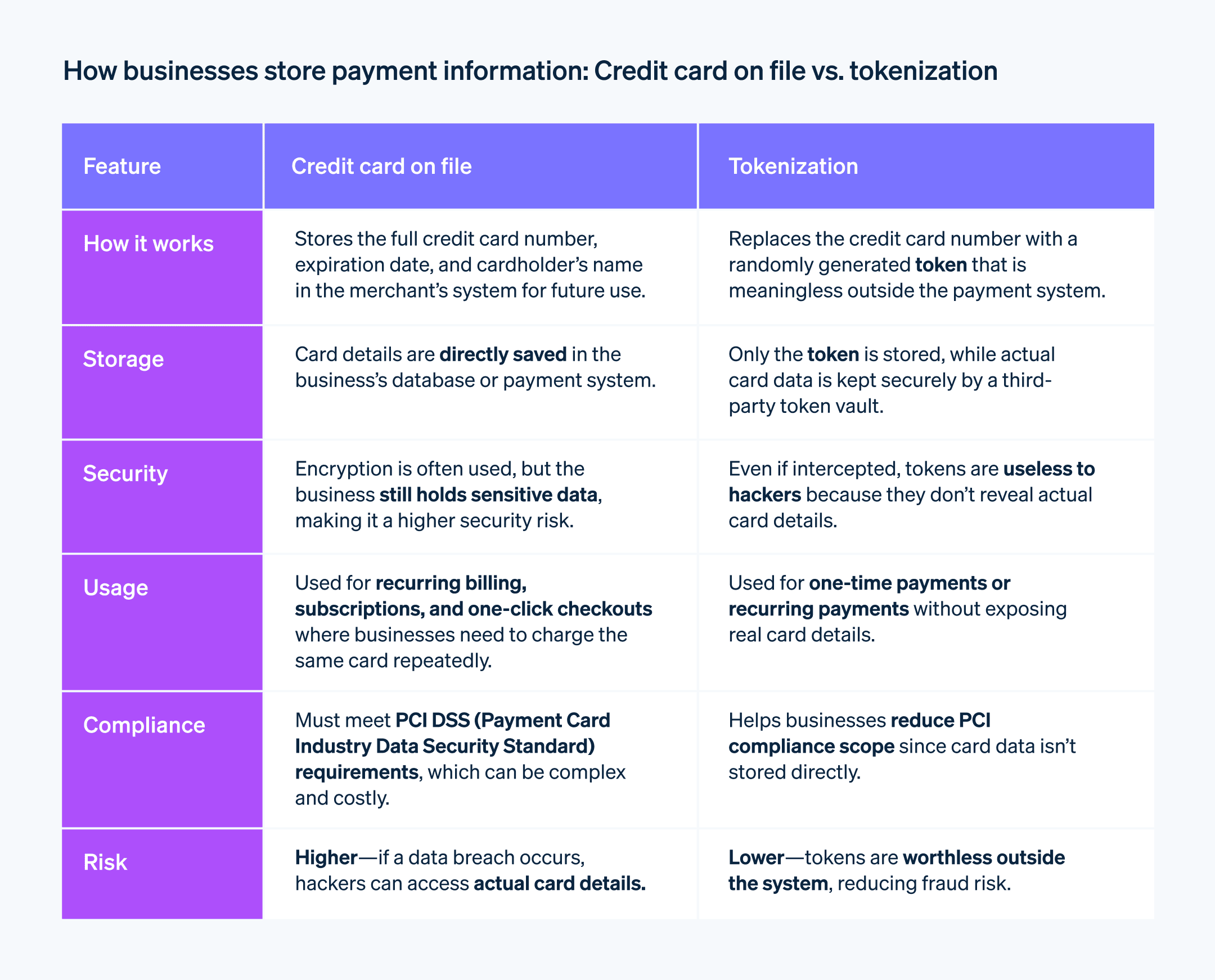信用卡存档是指企业将客户的信用卡信息保存在其支付系统中。这些信息通常包括卡号、有效期和持卡人姓名。这种设置使交易更加快捷方便。在经常性账单情况下,如订阅服务或经常性采购时,企业可以自动从存储的信用卡中扣款,而不需要客户每次都重新输入信息。
这类支付有很大的市场。到 2020 年,美国人平均拥有 12 个媒体和娱乐平台付费订阅,千禧一代平均拥有 17 个。
但存储客户卡需要注意安全。要打造最安全、最便捷的客户体验,企业必须了解存档卡是如何工作的,以及存储和使用客户支付方式的风险和挑战。企业有责任保护这些敏感信息,防止未经授权的访问,并遵守数据保护法规。以下是您需要了解的内容。
目录
- 存档信用卡的常见用途
- 存档信用卡如何使用?
- 信用卡存档与令牌化有何不同?
- 将信用卡存档的利弊
- 企业将信用卡存档的替代方法
存档信用卡的常见用途
客户卡的存档方式发生了很大变化。企业会记录客户卡的详细信息,以便客户在自己的账户上进行消费。这种方法对于经常光顾的顾客来说很实用,通常是在当地的小商店里,建立在相互信任的基础上。
随着业务的增长和交易的复杂化,人们开始转向数字解决方案。现在,企业使用加密系统来存储客户的银行卡信息,使交易更快捷,欺诈风险更低。这一变化使现代企业更容易管理经常性付款,也使客户更轻松地购物。以下是一些通常使用存档卡的企业类型:
订阅服务:许多企业提供需要定期付款的服务,如软件、流媒体平台或成员俱乐部的月度订阅付款。存档信用卡后,这些企业就可以在每个账单周期自动从客户的卡中扣款。这种设置减少了每次人工付款的需要,从而实现了不间断服务。
有经常性订单的其他业务:与订阅服务类似,一些企业 - 尤其是食品和零售行业 - 存档信用卡来用于支付经常性订单。经常订购相同产品的客户可以从这一系统中获益,因为它可以通过自动重新订购和结算来节省时间和精力。
招待费和租金:酒店和汽车租赁公司通常会将信用卡存档以收取杂费。顾客在办理签入手续时提供一张信用卡,用于支付潜在的额外费用,如客房服务或车辆损坏等,这使结账体验更加轻松。
公用事业和服务提供商:许多公用事业公司和服务提供商鼓励客户将信用卡存档,以便每月支付账单,如电费、水费或互联网服务。这种方法可确保账单按时支付,并降低因错过账单支付而导致服务中断的风险。
医疗保健服务:在医疗保健领域,特别是在个人持续治疗方面,将信用卡存档有助于简化付款流程。它可以为定期预约或治疗快速计费,而无需每次都处理付款。
电子商务零售商:电子商务平台经常存储客户信用卡详细信息,以方便快速结账。在需要快速完成交易的情况下,如在闪购或购买可能很快售罄的热门商品时,客户尤其喜欢这种便利性。
紧急服务:有些服务,如道路救援或紧急维修服务,会将信用卡存档以加快服务派遣,而不必担心未及时预先付款。在即时服务比即时付款更重要的情况下,这种方法非常有用。
信用卡如何存档?
以下是流程概览:
初始设置:首先,客户向企业提供信用卡详细信息。这通常发生在购买或注册服务时。客户的银行卡信息 - 包括卡号、有效期和银行卡验证值 (CV) - 被输入企业的支付系统。
数据存储:一旦客户提供了其详细信息,企业就会将这些信息存储在其支付处理系统中。这种存储必须符合数据安全标准,以保护信息免遭未经授权的访问。数据通常会加密或令牌化以增加安全性。
授权今后使用:客户通常会同意让企业在今后的交易中从他们的卡中扣款。该协议通常是服务条款和条件的一部分,可能包括有关如何使用银行卡、用于何种目的以及客户如何取消该授权的详细信息。
自动计费:对于经常性付款,如订阅或包月服务,企业会在约定的时间间隔自动从存储的信用卡中扣款。这一过程无需客户每次手动付款。
简化交易:在网上购物等情况下,将信用卡存档可改善结账流程。客户无需每次都输入银行卡信息,就能更快地完成购物。
安全措施:企业必须采取安全措施保护存储的信用卡信息。这包括遵守行业标准,如支付卡行业数据安全标准(PCI DSS)、使用安全的服务器,并确保他们的支付网关是安全的,不会泄密。
更新银行卡信息:如果银行卡过期或更换,客户需要向企业更新银行卡信息。有些企业可能会在卡即将到期时发出通知,提醒客户更新信息。
客户控制和访问:客户通常可以查看和管理自己的信用卡信息,通常是通过客户账户门户网站。他们可以根据需要更新卡的详细信息、删除卡或添加卡。
信用卡存档与令牌化有何不同?
在支付处理过程中,信用卡存档和令牌化是两个不同的概念,但为了提高安全性和便利性,它们经常一起使用。下面说明对每个概念及其应用方式:
信用卡存档
当企业将信用卡存档时,就意味着它在支付系统中存储了客户信用卡的详细信息,如卡号、有效期和持卡人姓名。这样,企业就可以在交易时从卡中扣款,而无需客户重新输入详细资料。这种方法广泛用于定期付款或订阅。不过,存储信用卡信息需要采取严格的安全措施,以防止数据泄露并符合行业标准。
令牌化
令牌化是一种保护信用卡数据的安全措施。该程序用一种称为“令牌”的唯一标识符取代信用卡详细信息。该令牌可用于交易,而不会泄露信用卡信息。真实的银行卡数据安全地保存在令牌库中,通常由第三方服务提供商管理。处理交易时,将通过支付网络发送令牌,而不是真实的银行卡信息。即使令牌被拦截,实际信用卡信息仍然是安全的。

信用卡存档的利弊
将信用卡存档是许多企业的标准做法,但这种做法既有潜在的好处,也有潜在的弊端:
优点
改善现金流:将信用卡存档意味着企业可以更快地实施计费和收款流程。这对于采用经常性收入模式(如订阅服务)的企业来说尤其如此。账单流程自动化意味着企业可以依靠稳定的资金流入,减少人工开票和跟进付款的需要。
为客户提供更多便利:将信用卡存档可让客户更快、更方便地进行交易。这种便利可以改善客户体验,提高客户满意度和忠诚度。在电子商务场景中,这也可以加快结账速度,减少购物车放弃的比率。
减少行政开销:自动计费减轻了人工支付处理的管理负担。这可以降低人力成本,减少用于行政任务的时间,让员工专注于更有成效的活动。
更多销售机会:当客户的信用卡存档时,他们可能会更倾向于冲动购物或选择额外服务,因为他们知道付款流程已经简化。这可以提高平均交易额,促进销售。
缺点
安全和合规要求:在存储信用卡信息的同时,也要承担维护数据安全的责任。企业必须遵守 PCI DSS 和其他相关数据保护标准,这可能需要对安全存储解决方案和持续安全措施进行大量投资。
数据泄露的风险:持有敏感的客户数据会增加数据泄露的风险。如果企业的安全系统遭到破坏,可能会导致经济损失、声誉受损和法律后果。数据泄露对小型企业的影响尤为严重。
付款处理费用:虽然将信用卡存档可以方便计费,但也会产生费用。支付处理商通常对交易收取费用。企业还可能面临拒付或有争议的收费,这可能会产生额外的成本和管理工作。
管理卡信息更新:企业需要跟踪卡的到期和更新情况。这可能会变得复杂,尤其是在客户群庞大的情况下。不及时更新银行卡信息会导致拒绝交易和服务中断,从而可能影响客户关系。
企业保留信用卡档案的替代方法
对于希望简化客户支付体验的企业来说,将银行卡存档并不是唯一的选择。替代方案包括各种支付方式和技术,可提供不同程度的安全性和便利性,其中包括:
直接银行转账 (ACH):企业可以使用自动清算所转账,即客户从其银行账户付款。这种方法产生的交易费通常低于信用卡处理费,对于定期付款也同样方便,只是处理时间可能更长。
数字钱包和支付服务:服务,如 PayPal、Apple Pay、Google Pay,或其他移动支付系统,让客户安全地存储其支付信息,并在不向企业提供信用卡详细信息的情况下进行支付。这些服务通常提供强大的加密功能和快捷的支付流程。
加密货币支付:接受加密货币可以帮助企业最大限度地降低交易费用,并提供与传统银行系统无关的支付方式。由于区块链技术的存在,加密货币可以提供高度安全性,但由于其波动性和使用过程中的学习曲线,加密货币可能不太方便使用。
预付账户:企业可以让客户在账户中预存资金,每次购物时提取。这可能是一种更安全的支付方式,因为可用资金是有限额的,而且还能提高客户的忠诚度。
移动 POS 系统:企业可以使用移动销售点系统进行当面交易。这些系统可以接受包括信用卡在内的各种支付方式,而无需将卡的详细信息存档。它们通常具有强大的安全功能和立即确认付款的便利性。
发票支付:对于企业对企业 (B2B) 交易或提供的服务,企业可以开具附有付款条件的发票。客户可以使用各种方法支付这些发票,包括支票、银行转账或在线支付门户网站,这些方法不需要企业存储支付信息。
生物识别支付系统:生物识别支付系统是一种新兴技术,使用指纹或面部识别来验证支付。由于不需要实体卡或记忆密码,它们有可能提供强大的安全性和高度的便利性。
非接触式支付:Tap to Pay技术让客户通过在读卡器上轻触支付卡或移动设备来付款。这与传统的信用卡交易一样快捷安全,企业无需存储任何详细信息。
在将这些替代方法与存档卡方法进行比较时,重要的是要考虑到安全和方便程度的不同。例如,数字钱包提供了与信用卡类似的便利,但由于不会向企业暴露信用卡的详细信息,因此增加了一层安全性。从交易性质上说,直接银行转账可能更安全,但由于处理时间较慢,可能不太方便。每种选择都有自己的权衡取舍,企业必须根据自己的具体需求、客户偏好和运营能力进行综合评估。
本文中的内容仅供一般信息和教育目的,不应被解释为法律或税务建议。Stripe 不保证或担保文章中信息的准确性、完整性、充分性或时效性。您应该寻求在您的司法管辖区获得执业许可的合格律师或会计师的建议,以就您的特定情况提供建议。